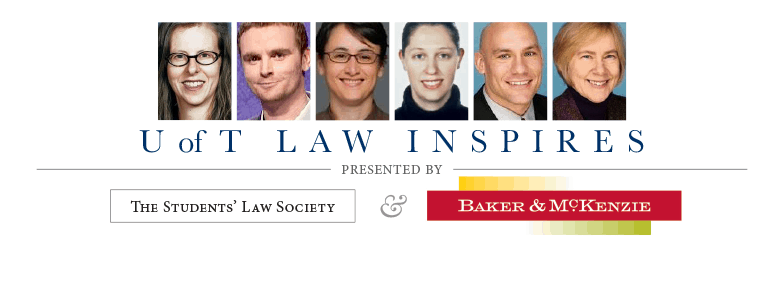By: Tali Green (2L)
Most people get inspired by pleasant things, such as rainbows and baby giraffes. But if the almost-packed Victoria Chapel on March 3rd indicated anything about U of T Law students, it’s that we prefer to get inspired by things of questionable loveliness, like the implications of criminally sanctioning polygamy and how to legally resolve international water conflicts. And we don’t like to waste any time getting inspired. Which is why we prefer to have six issues of immense social and economic significance presented to us in a snappy ten minutes or less.
It all started in 2013 when Jonathan Tam, then a 3L and now an associate at Baker & McKenzie, decided that he wanted to bridge what he sensed was a disconnect between students and faculty at the law school. He figured he can do this by giving students a glimpse of what profs really care about. Turns out– and this may come as a shock so please read carefully – profs tend to care way more about their own research than the topics they happen to be teaching.
When Tam was an undergraduate at Harvard, he attended a TED-talk-like event called – and let’s forgive them for this name – “Harvard Thinks Big,” where profs presented the crux of their research in just a few minutes. Tam wanted to import the event to U of T Law. Besides making us more familiar with our profs, such an event had the potential to inspire, by, as Tam puts it, “opening your eyes to something that you haven’t thought of before and compelling you to act upon it.”
But why the rush? Why do all these events – from TED to Harvard Thinks Big to U of T Law Inspires – impose such draconian time limits on smart people trying to share their solutions to the most burning problems of their day? “The prof has to hone their entire thesis for a ten minute pitch”, Tam explains. “When they have to focus it that much, they can only communicate so much, and, like in TED talks, there is a focus on showmanship and theatrical aspects.” It could also be this: by boiling down a thesis to its core and then describing it with stunts and jokes, you’re able to cover a variety of important topics in less time while engaging an audience with the attention span of a tweet.
In true Inspires fashion, Tam didn’t waste any time turning his idea into a reality. He got approvals from the Dean, money for food from his soon-to-be articling firm Baker & McKenzie, a roster of star profs, and then went on a mad marketing campaign across campus and Facebook. The event was so good that the SLS took it on and has been organizing it annually ever since.
This year, 2L Social Affairs rep Andrew Lynes held the reins. How did he choose presenters? For one thing, Lynes insisted that at least half of the presenters are women. “That was a big deal to me because it is something that people should be paying attention to these days,” Lynes explained. “The faculty is only so diverse in other ways.” He also wanted to find at least some profs that had taught 1Ls to try to draw the 1L crowd. Besides that, Lynes looked for an SJD student to increase the interaction between JDs and graduate students. In general, he chose speakers whom he had personally heard before or who were recommended by a trustworthy source.
So what were this year’s talks about? The following are not-particularly-theatrical summaries of what were six quite interesting presentations. If you read really fast it might come out to about a minute per presentation:
Professor Brenda Cossman asked whether polygamy was inherently exploitative. She said that the criminal prohibition on polygamy restricts relationships that are entered into by choice and are considered not exploitative – like polyamory. She also raised the possibility that women could be genuinely satisfied in polygamous relationships. Cossman thinks that the most dangerous result of prohibiting all forms of polygamy is the lack of differentiation between consensual and non-consensual sex. She urged us to demand a legal regime that recognizes that women are “capable of robust forms of consent and of removing that consent.”
Professor Niblett looked at the unintended consequence of raising the minimum claim amount in small claims court. Small claims court used to have a limit of $10,000, but because it was so expensive to bring claims that were just a bit above $10,000, the government increased the limit from $10,000 to $25,000. Did that enhance access to justice as it was supposed to? No, and apparently it did just the opposite. By sorting through thousands of small claims court cases according to postal codes, Niblett was able to determine that the level of claims brought by poorer people (ie: those who reside in poorer parts of the city) dropped, and the level of claims brought by wealthier people (ie: those who reside in wealthier parts of the city) increased. Niblett attributes this see-saw effect to the increased litigation costs of using the small claims system as a whole and to the problem of poor people no longer being able to identify with a court with such a high limit.
Professor Mariana Prado illustrated the tension between equality of outcome and equality of opportunity. She showed us a cartoon entitled “Equality.” We saw two images side by side of three guys trying to watch a baseball game behind a very tall fence. The guys are of varying heights – tall, medium, short. The medium and short guys are too short to see the game behind the fence. The left image is what equality would mean “to a conservative” – each guy is standing on one box. The short guy still can’t see the game, while the medium guy can see the game and the tall guy can see the game from an extra (and arguably unnecessarily) high perch. The right image is what equality would mean “to a liberal” – the tall guy has no box – but he can see the game. The middle guy has one box – and now he can see the game just as well as the tall guy. The short guy is standing on two boxes – and also able to see the game as well as the other two. While this image was meant to make us prefer the liberal approach, Prado asked how we would feel if the short guy had stolen the tall guy’s box, or he had guy bribed someone to get his extra box. Ultimately, Prado left us to consider the policy implications of whether equality of outcome – all guys get to see the game equally but with varying amount of boxes – was preferred to equality of opportunity – where all the guys have just one box but see the game differently.
Tamar Meshel, the only SJD among the speakers, described what happens when two countries start fighting for a very scarce amount of fresh water. Some jarring statistics to set the scene: 76% of the world’s population lives in a “distressed water” situation. One and a half billion people in the world do not have access to fresh water. Sometimes a single river basin crosses international borders, and for two thirds of those shared river basins there is no mechanism for resolving disputes over who gets the water. Meshel wants to use international law and Boolean algebra to help resolve those disputes before they get bloody. It sounded promising and impressive, but ten minutes wasn’t enough for the average non-SJD (or maybe just me) to grasp how it would all work out.
Professor Benjamin Alarie introduced us to one of his newest Tax Law students – Blue J, a computer. When IBM developed a computer that would beat humans at their own thinking game, it asked U of T Law if it could test the machine’s abilities in the legal profession. Alarie described how Blue J is probably smarter than any law student in his class: Blue J can understand legal consequences and recall everything, he can read everything perfectly and is confident in the answers he gives, and apparently he is not a bad conversationalist, either. So why is this not the end of the world for (human) lawyers as we know it? Alarie says Blue J and others like him can help us find weaknesses in our analyses, direct the right kind of clients to the right kind of lawyers, and facilitate dispute resolution more quickly. And on top of all that (not mentioned explicitly by Alarie but obviously implied): Blue J will have a very low dry cleaning bill which will translate into even more savings for clients.
Professor Jennifer Nedelsky wants us to all work part time. And then take care of people the rest of the time. She developed this theory in order to address what she considers an unequal burden of care placed on the average working woman who cannot afford care. Nedelsky is also concerned about the trend of wealthy women farming out care to poor women, which she believes exacerbates the problem of women being sidelined into low-paying jobs. Nedelsky acknowledges that there are some deeply held attitudes that will have to change for her policy to work, but she urges people to re-evaluate their long standing beliefs. For one, she bemoans that it is “a marker of being important” that other people do the care work for one’s family. Similarly, she wants men to “want to care” but that will depend on an even greater shift: “the capacity to care has to replace the capacity for violence and domination as the marker of male sexuality.”
Tam was right – because of the sheer variety of topics, everyone probably walked away from U of T Law Inspires having learned something new from at least one of the talks. As for whether they were compelled to action – time will tell.







